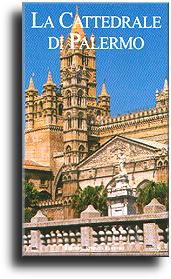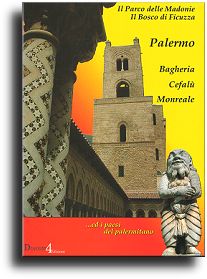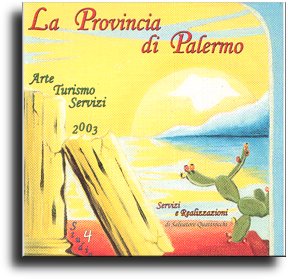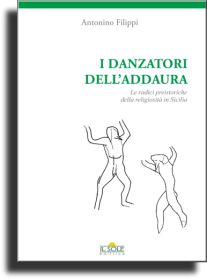
Duration: 20 minutes
Available in Italian language.
Information about how to purchase this video
Authors: Maria Rosaria Falcone e Romilda Nicotra
Available in English, French, German and Italian language.
Information about how to purchase this book
The Cathedral, built towards the end of the XII century for will of the archbishop Gualtiero Offamilio, shows a prevailing Sicilian-Norman style, animated by architectures which hide numerous changes. It was divided according to basilical Latin cross plan to which it was added, between 1781 and 1801, according to design made by Ferdinando Fuga (1699-1781), the aisles, the wings of transept and the majestic dome.
Its external front is closed between two high towers with double lancet window and small columns. The middle portal, datable to 1400, is enriched by a double lancet window and by Aragonese coats of arms and by the town Senate. The main front is jointed to the bell-tower, of medieval taste, by two pointed arches and shows a beautiful portal to enter into churh enriched with symbols of four Evangelists (a lion, an angel, a bull and an eagle). The southern front is in Gothic-Catalan style and shows three pointed arcades and a gable ornated with Gothic elements.
INSIDE: work of indescribable artistical value and meticulous workings which reflect various styles of different ages, it contains numerous masterpieces of local and Sicilian skill. In it stands out the first chapel of the right part in which are kept sarcophagi of royals belonging to the Svevian dinasty (Federick II`s, his wife Costance of Aragon`s and Henry IV`s) and the graves of Roger II and of his daughter Costance of Altavilla.
TREASURE: it is possible to enter from the right area of the transept and keeps a capitular stick with beautiful ivory engravings of Sicilian art of the XVII century; numerous jewels of queen Costance of Aragon as well as some rings and the precious imperial gold crown, monted with precious stones, pearls and diamonds.
CRYPT: keeps various graves of bishops among which it stands out a sarcophagus of Roman period with a rilief of figures of nine Greek muses and god Apollo.
Author: Salvatore Quattrocchi
Information about how to purchase this book
Palermo and the 80 municipalities of its province
Several pages with a lot of great pictures are dedicated to each town, illustrating the town, its history, the most intersting places to see, the monuments.
A list of useful information like Hotels and other receptive structures completes the description of each town.
The books also offers great pages about the naturalistic resources of the privince of Palermo, like those dedicated to the Madonie`s Park and the Forest of Ficuzza.
Author: Salvatore Quattrocchi
Information about how to purchase this Cd-rom
The province of Palermo and all of its municipalities
The town and places files contain or link to photos taken in those locations. Descriptions of local festivals are included the files for some towns.
A first section is devoted to the Chief Town of Sicily, Palermo. This section illustrates the origins, the famous people, the history, and much more information about this town and its traditions. A second section is devoted to the cultural aspects of the Province. This section illustrates the agriculture, the poesy, the proverbs and the cooking recipes. A third section illustrates the Madonie`s Mountains Park with a fully description of the same Park and a lot of wonderful pictures. A fourth and final section, a very important one, illustrates each municipality of the Province of Palermo. For each town the origins, the famous people, the history, and much more information about the town and its traditions are fully described with a lot of pictures too.
System Requirements:
Author: Antonino Filippi*
Information about how to purchase this book
Available Italian language
"It remains to observe them in disbelief, amazed by the forms, from those few lines, etched into the hard limestone, show with wonder and precision the features of human bodies. You hear them move, shake within that thread of rock carved by the chisel that has them imprisoned for millennia, as if they wanted to keep walking, running, dancing, following indefinitely a cadence, a rhythm. They are there, some with arms raised, some bending, other independent or cross-legged; a swirl of mute characters, but for thousands of years they are trying to tell us something."
Certainly, a doubt in the mind whale immediately. They will be true? They were really made in distant prehistory? There we wondered and maybe getting a little 'we ask of him. Watching them are very modern! Some seem to be moving in a circle like the dancers of Matisse; others appear from the depths of the shadow, as friends of Munch that nell'Urlo follow him from the bottom of the road; others have faces metaphysical, worthy of a painting by De Chirico. Their preservation to this day is a miracle; so it seemed like a miracle their sudden discovery, in 1952, in a place so secluded, but just a short walk from the outskirts of one of the largest metropolis in the middle of the Mediterranean.
In the more than sixty years have passed since the discovery of graffiti in the cave dell'Addaura, many pages have been written about these strange people dancing but, despite this, many questions remained unresolved, and still admiring many doubts we recall to mind. I felt so, aware of the many difficulties and the enormous risks, to tell their story, trying to climb the huge chasm carved by the passage of time that separates us from them. I wanted to take this long road, driven by the knowledge that men and women depicted on the rock wall not only express a dance or pure emotions, but really want to say something concrete about ancient rituals and ancestral religions. This led me to try, maybe even a little 'to imagine, symbols and rituals of a Sicily where, thousands of years ago, the dancers dell'Addaura lived free'. (Introduction by the author).
(*) Antonino Filippi, born in Turin in 1967, teacher, graduated in archeology at the University of Palermo. He led historical and archaeological research in the Trapani area, working with the Superintendent BB.CC.AA. of Trapani. He is the author of monographs' Ancient settlements in the territory of Alcamo '(1996),' An ancient Mediterranean port. Archeology and history of Trapani from the archaic and Byzantine '(2005),' Prehistory and Early History Trapani '(2014). His articles have been published in journals and conference proceedings for studies on ancient Sicily. He collaborated with the publishing house 'The Sun' in the drafting of some documentaries. For the Regional Museum 'A. Pepoli 'of Trapani led the study of the collection of prehistoric finds.
|











 Palermo, Segesta, Erice, Mozia
Palermo, Segesta, Erice, Mozia
 Cathedral of Palermo
Cathedral of Palermo
 Palermo and the 80 municipalities of its province
Palermo and the 80 municipalities of its province
 CD PALERMO
CD PALERMO
 The dancers of Addaura. The origins of religion in Sicily.
The dancers of Addaura. The origins of religion in Sicily.